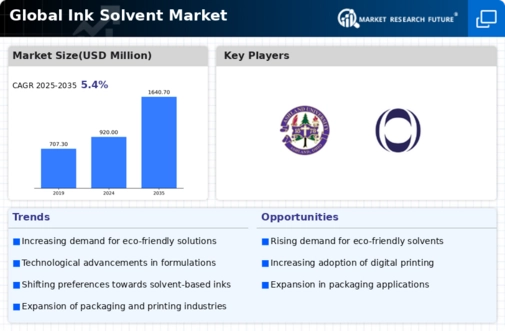Market Trends
Key Emerging Trends in the Ink Solvent Market
The Ink Solvent Market is experiencing several notable trends that are shaping its landscape:
Shift towards Environmentally Friendly Solvents: One of the prominent trends in the ink solvent market is the increasing demand for environmentally friendly solvent options. With growing environmental concerns and stricter regulations on volatile organic compounds (VOCs), there is a shift towards eco-friendly solvents derived from renewable sources or formulated to have low VOC content. Manufacturers are innovating to develop solvent formulations that meet sustainability goals while maintaining high performance in various printing applications.
Adoption of Bio-based Solvents: Bio-based solvents, derived from renewable resources such as plant-based materials or agricultural waste, are gaining traction in the ink solvent market. These solvents offer a more sustainable alternative to petroleum-based solvents, reducing dependency on fossil fuels and minimizing environmental impact. As consumers and industries prioritize sustainability, the demand for bio-based ink solvents is expected to continue rising.
Focus on Low Odor Formulations: Another trend driving the market is the demand for ink solvents with low odor properties. Printing applications in enclosed environments such as offices, homes, and commercial spaces require solvents that emit minimal odor during printing processes. Manufacturers are developing low odor solvent formulations to address this demand and improve user experience, particularly in indoor printing applications.
Rise in Digital Printing Technologies: The proliferation of digital printing technologies such as inkjet and UV-curable printing is influencing market trends in ink solvents. These technologies offer advantages such as high-speed printing, on-demand customization, and reduced waste compared to traditional printing methods. As digital printing continues to gain popularity across various industries, there is a growing demand for compatible solvent formulations optimized for digital printing processes.
Demand for Specialty Inks: The market is witnessing a rise in demand for specialty inks, including metallic inks, fluorescent inks, and security inks, which require specific solvent formulations. Specialty inks are used for applications such as packaging, labeling, and security printing to enhance visual appeal, brand differentiation, and counterfeit deterrence. Ink solvent manufacturers are developing specialized formulations to meet the unique requirements of specialty ink applications.
Focus on Performance and Compatibility: Ink solvent manufacturers are increasingly focusing on developing solvents that offer superior performance characteristics and compatibility with a wide range of substrates and printing equipment. High-performance solvents ensure optimal ink flow, drying time, adhesion, and color consistency, leading to high-quality prints and improved printing efficiency. Compatibility with different printing technologies and substrates enhances versatility and market competitiveness.
Expansion in Packaging and Labeling Applications: The packaging and labeling industry is a significant consumer of ink solvents, driving market trends in this segment. With the growing demand for packaged goods and consumer products worldwide, there is an increasing need for high-quality printed packaging materials and labels. Ink solvents play a crucial role in formulating inks for flexible packaging, labels, cartons, and corrugated boxes, catering to the diverse requirements of the packaging industry.
Technological Advancements in Solvent Formulations: Technological advancements in solvent formulation processes are driving innovation and product development in the ink solvent market. Manufacturers are investing in research and development to improve solvent properties such as drying time, color stability, print adhesion, and resistance to fading and abrasion. These advancements enhance the overall performance and reliability of ink solvents, meeting the evolving needs of printers and end-users.
Globalization of Printing Industry: The globalization of the printing industry is influencing market trends in ink solvents, with manufacturers expanding their presence in emerging markets and catering to diverse regional requirements. As printing activities and demand for printed materials grow in regions such as Asia-Pacific, Latin America, and the Middle East, there is an increasing need for locally produced ink solvents customized to regional preferences and regulatory standards.





Leave a Comment